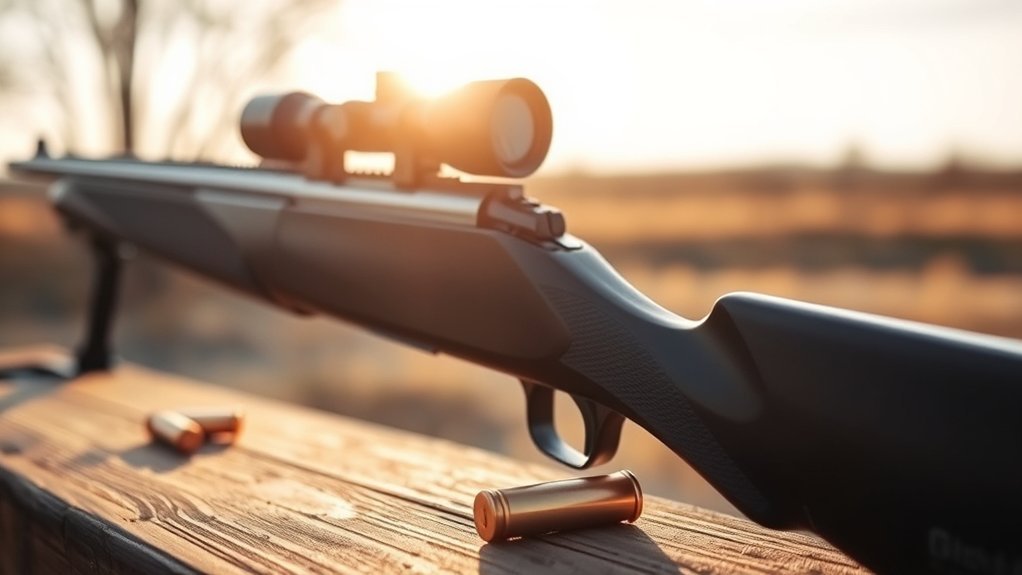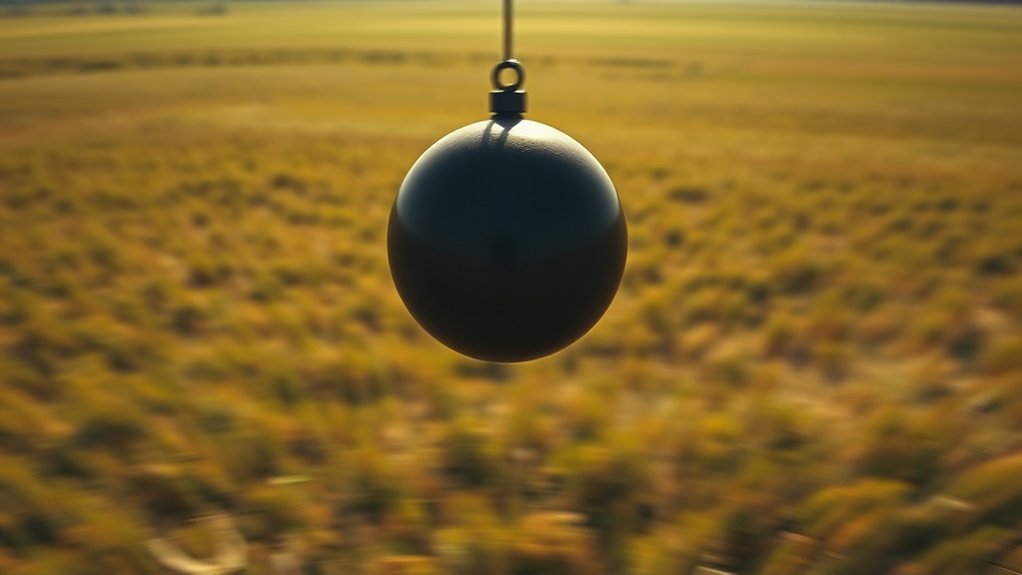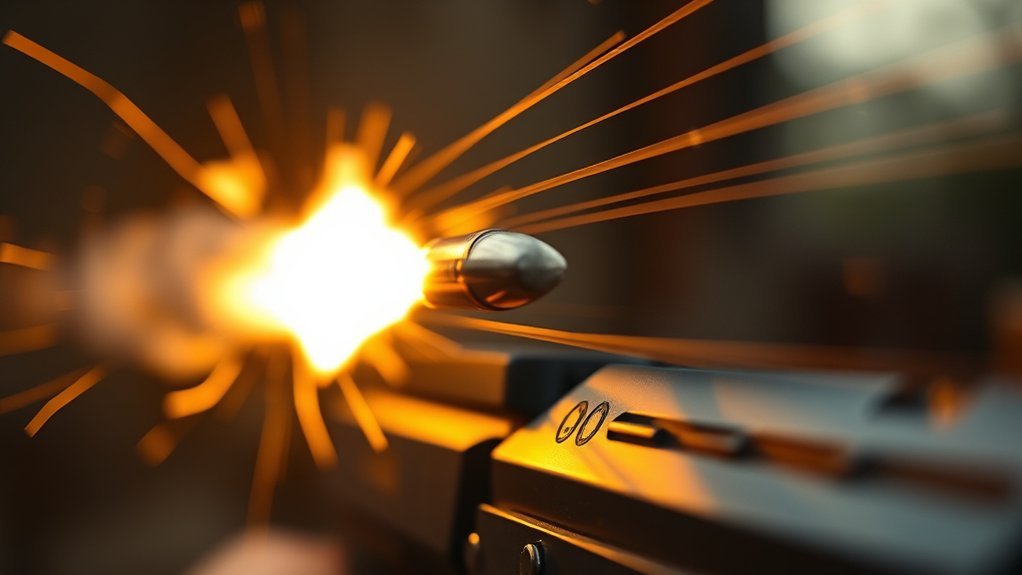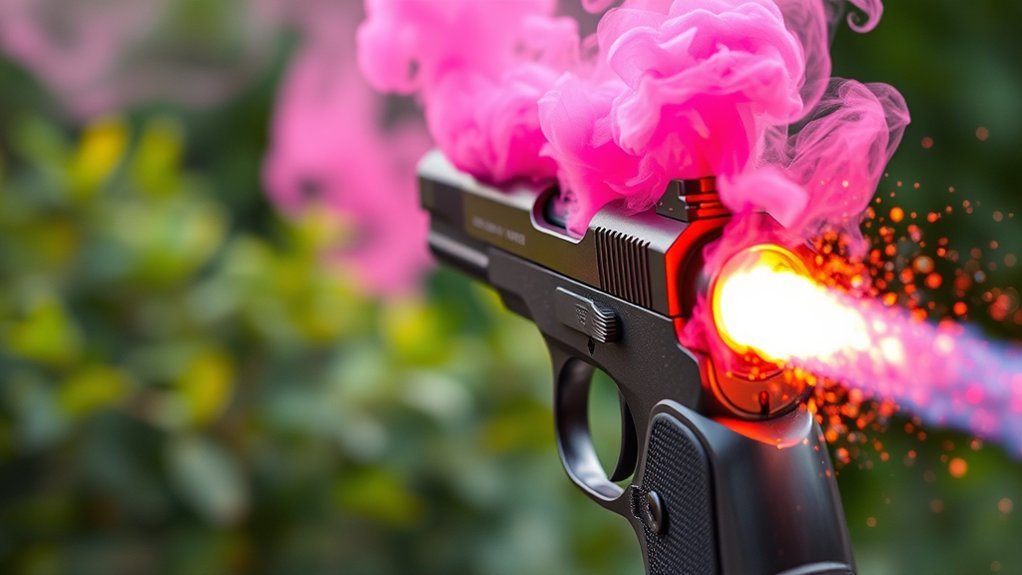When you fire a gun, the backward motion you feel is due to free recoil energy. This energy is a result of the momentum from the projectile, and understanding it is essential for effective shooting. It’s not just about handling the recoil; it’s about mastering it. With the right knowledge, you can improve your accuracy and performance greatly. So, how do you calculate this energy and what factors come into play?
Understanding Recoil and Its Importance

Understanding recoil is essential for anyone involved in shooting sports, weapon design, or ballistics, as it directly affects performance and accuracy. Recoil, the backward movement of a firearm when discharged, influences your shooting experience considerably. When you pull the trigger, the force generated by the bullet’s propulsion results in a counterforce that pushes the weapon away from you. This reaction can impact your aim, recovery time, and overall control. A firearm with excessive recoil may lead to flinching or reduced follow-up shot accuracy. Conversely, a well-managed recoil allows for quicker target reacquisition and improved shot placement. By grasping the importance of recoil, you can enhance your shooting technique, optimize firearm selection, and ultimately improve your performance on the range or in the field.
The Physics Behind Free Recoil Energy

Although recoil might seem like a simple backward push, the physics behind free recoil energy involves complex principles of momentum and energy transfer. When a projectile is fired, the system conserves momentum. You’ll notice that the forward motion of the projectile generates an equal and opposite reaction on the firearm, resulting in recoil. This interaction illustrates Newton’s third law of motion: for every action, there’s an equal and opposite reaction. As the bullet accelerates forward, the gun experiences a backward movement, transferring kinetic energy. The magnitude of this recoil energy depends on the mass of the projectile and its velocity at the moment of firing. Understanding these principles helps you appreciate the dynamics of shooting and weapon design.
Calculating Free Recoil Energy

To calculate free recoil energy, you’ll need to take into account the mass of the projectile and its velocity at the moment of firing. Use the equation for kinetic energy: ( E = frac{1}{2} mv^2 ), where ( E ) is the energy, ( m ) is the mass of the projectile in kilograms, and ( v ) is its velocity in meters per second. This formula gives you the energy imparted to the projectile, which equals the recoil energy transferred to the firearm. Remember, the total recoil energy is equal to the kinetic energy of the projectile, as per the law of conservation of momentum. By accurately measuring these variables, you can effectively determine the free recoil energy of your firearm.
Factors Influencing Recoil Energy
Several key factors influence recoil energy, affecting how a firearm behaves during discharge. Understanding these elements helps you manage recoil more effectively.
Several key elements impact recoil energy, shaping the shooting experience and enabling better recoil management.
- Projectile Mass: Heavier projectiles generate more recoil energy due to the increased momentum they carry upon firing.
- Powder Charge: A larger powder charge produces more gas pressure, resulting in a higher recoil force when the bullet exits the barrel.
- Firearm Weight: Heavier firearms absorb more recoil energy, reducing the perceived kick during shooting, while lighter firearms amplify it.
Measuring Recoil in Different Firearms
When measuring recoil in different firearms, it’s essential to contemplate the unique characteristics of each type, as they can substantially influence your shooting experience. Start by evaluating the firearm’s caliber, as a larger caliber typically produces more recoil. Next, consider the action type—semi-automatics often absorb some recoil through their mechanisms, while bolt-actions may deliver a more pronounced kick. You should also examine the stock design; a well-padded stock can mitigate felt recoil considerably. Using a recoil gauge can provide precise measurements, and comparing these values across different firearms will help you understand how various designs affect recoil. Ultimately, knowing these factors will enhance your shooting comfort and accuracy during practice or competition.
The Role of Weight and Velocity
When considering free recoil energy, the weight of your firearm and the velocity of the projectile play critical roles. A heavier gun can absorb more recoil, while increased velocity generates greater energy transfer upon firing. Understanding these dynamics helps you manage recoil effectively and improve your shooting experience.
Impact of Weight
While understanding the dynamics of free recoil energy, it’s important to recognize how weight influences both recoil and projectile velocity. The weight of your firearm and ammunition plays a significant role in determining the felt recoil and the efficiency of energy transfer.
- Heavier firearms generally absorb more recoil, reducing the shooter’s experience of kick.
- Lighter projectiles can lead to higher velocities but may increase perceived recoil.
- The balance between weight and bullet mass affects overall stability and accuracy during shooting.
Influence of Velocity
Understanding how velocity interacts with weight is essential for grasping free recoil energy. The relationship between these two factors directly influences the recoil experienced when firing a projectile. As you increase the velocity of the projectile, the kinetic energy rises exponentially, given that kinetic energy is proportional to the square of velocity. This means that even a slight increase in speed can greatly escalate recoil energy. Conversely, if you reduce the weight of the projectile while maintaining high velocity, you’ll experience a different recoil dynamic, potentially leading to a sharper kick. As a result, when selecting ammunition or designing firearms, consider how the interplay of weight and velocity will affect both performance and shooter comfort.
Impact on Shooting Performance
How does free recoil energy influence your shooting performance? Understanding this concept is essential for enhancing your accuracy and consistency. High free recoil energy can lead to several performance issues that affect your shots.
- Flinching: A strong recoil can cause you to flinch, affecting your trigger control and shot placement.
- Fatigue: Repeated exposure to high recoil can lead to fatigue, compromising your focus during extended shooting sessions.
- Follow-through: Excessive recoil may disrupt your follow-through, which is important for maintaining alignment and accuracy after the shot.
Managing Recoil for Improved Accuracy
To achieve improved accuracy in shooting, managing recoil effectively is key. First, make certain your grip is firm and consistent; a relaxed hold can lead to unwanted movement during firing. Position your body to absorb recoil—stance and weight distribution play significant roles. Lean slightly into the shot, enhancing stability. Use a recoil pad to soften the impact against your shoulder, allowing quicker follow-up shots. Additionally, practice controlled breathing—exhale just before you pull the trigger to minimize flinching. Finally, consider your ammunition; lighter loads can reduce recoil while still offering adequate performance. By focusing on these techniques, you’ll enhance your shooting precision and develop a more consistent shot placement, ultimately leading to improved accuracy in your shooting endeavors.
Free Recoil Energy in Firearm Design
While the design of a firearm can greatly influence its performance, free recoil energy plays an essential role in determining how a shooter experiences and manages recoil. This energy directly affects control and accuracy, making design choices critical. When you consider free recoil energy, focus on these key aspects:
Free recoil energy significantly impacts a shooter’s control and accuracy, emphasizing the importance of thoughtful firearm design.
- Weight Distribution: Heavier firearms tend to absorb more recoil, reducing the impact felt by the shooter.
- Barrel Length: Longer barrels can decrease recoil by providing more time for the gases to expand before exiting.
- Stock Design: Ergonomic stocks can help distribute recoil forces more evenly, enhancing comfort and stability during firing.
Practical Applications for Shooters
Understanding free recoil energy is essential for shooters looking to enhance their performance and comfort. By calculating free recoil energy, you can determine how much recoil you’ll experience, which directly affects your shooting accuracy and control. If you’re using a high-energy cartridge, understanding this concept can help you select appropriate gear, like recoil pads or muzzle brakes, to mitigate the effects. Additionally, knowing your firearm’s free recoil energy allows you to practice more effectively, as you can adjust your stance and grip for maximum stability. Ultimately, this knowledge empowers you to make informed decisions about your setup, ensuring you maintain accuracy and reduce fatigue during extended shooting sessions. Embrace free recoil energy to refine your shooting experience.
Conclusion
So, while you might think that mastering free recoil energy is all about brute strength and grip, it’s actually a delicate dance of physics. Understanding how recoil works can make or break your shooting game. It’s ironic, isn’t it? The key to better accuracy lies not in muscling through the kick, but in embracing the science behind it. By managing recoil, you’ll not only shoot better but also enjoy your time at the range much more.

